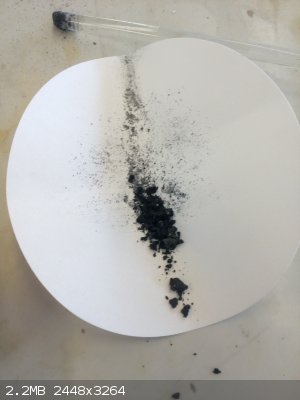morsagh
Hazard to Others
  
Posts: 187
Registered: 20-2-2014
Member Is Offline
Mood: No Mood
|
|
Cuprate
So today i tried to prepare sodium cuprate(III). I heated mixture of 0,5g sodium peroxide and 0,5g copper(II) oxide. Mixture melted and than quickly
solidified. When product was put directly in flame, orange solid is produced. Product is not very soluble in water, and violently reacts with diluted
sulfuric acid while lot of gas is produced. Do you think this blue/black solid can be sodium cuprate?

Attachment: phpsT55Ir (2.2MB)
This file has been downloaded 561 times
[Edited on 17-1-2017 by morsagh]
[Edited on 17-1-2017 by morsagh]
|
|
|
AJKOER
Radically Dubious
    
Posts: 3026
Registered: 7-5-2011
Member Is Offline
Mood: No Mood
|
|
Per Wikipedia on Cuprate (https://en.m.wikipedia.org/wiki/Cuprate ):
"This dark blue diamagnetic solid is produced by heating potassium peroxide and copper(II) oxide in an atmosphere of oxygen:[2]
K2O2 + 2 CuO → 2 KCuO2 "
Also, per Wikipedia on K2O2 (https://en.m.wikipedia.org/wiki/Potassium_peroxide ):
"Potassium peroxide reacts with water to form potassium hydroxide and oxygen:
2 K2O2 + 2 H2O → 4 KOH + O2 "
Assuming similar chemistry for sodium salts, my concerns would be to relating to the presence of water vapor and heating in an oxygen rich atmosphere.
|
|
|
Tsjerk
International Hazard
    
Posts: 3022
Registered: 20-4-2005
Location: Netherlands
Member Is Offline
Mood: Mood
|
|
Oxygen would be enriched by heating peroxide salt in a tube and water would be driven of by the same heat. I would say you might have succeeded; can
you think of any other tests to confirm it is cuprate?
[Edited on 19-1-2017 by Tsjerk]
|
|
|
DFliyerz
Hazard to Others
  
Posts: 241
Registered: 22-12-2014
Member Is Offline
Mood: No Mood
|
|
Perhaps try dissolving it in water? I remember making a cuprate solution by electrolysing a sodium hydroxide solution with a copper anode, and it was
a very dark blue color.
|
|
|
morsagh
Hazard to Others
  
Posts: 187
Registered: 20-2-2014
Member Is Offline
Mood: No Mood
|
|
Product of electrolysis is Na2Cu(OH)4, not cuprate with Cu(III). Any other ideas?
|
|
|
ave369
Eastern European Lady of Mad Science
   
Posts: 596
Registered: 8-7-2015
Location: No Location
Member Is Offline
Mood: No Mood
|
|
By the way, can you make Cu2O3 with persulfate as oxidizer? I tried ammonium persulfate on Cu(OH)2, but I forgot about the alkali (NaOH) that was used
to precipitate Cu(OH)2. It reacted with the ammonium salt, and the resulting ammonia gave the characteristic deep blue color of the ammino copper (II)
complex.
Should I try this with potassium persulfate? I've got loads of the ammonium persulfate but little of the potassium salt.
Smells like ammonia....
|
|
|
AJKOER
Radically Dubious
    
Posts: 3026
Registered: 7-5-2011
Member Is Offline
Mood: No Mood
|
|
A short prior thread on the topic at http://www.sciencemadness.org/talk/viewthread.php?tid=64346 .
|
|
|
morsagh
Hazard to Others
  
Posts: 187
Registered: 20-2-2014
Member Is Offline
Mood: No Mood
|
|
We are talking about Cu(III) cuprate not Cu(II) like Na2Cu(OH)4.
|
|
|